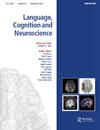Meaning creation in novel noun-noun compounds: humans and language models
IF 1.8
3区 医学
Q2 AUDIOLOGY & SPEECH-LANGUAGE PATHOLOGY
引用次数: 0
Abstract
The interpretation of novel noun-noun compounds (NNCs, e.g. “devil salary”) requires the combination of nouns in the absence of syntactic cues, an interesting facet of complex meaning creation. Here we examine unconstrained interpretations of a large set of novel NNCs, to investigate how NNC constituents are combined into novel complex meanings. The data show that words’ lexical-semantic features (e.g. material, agentivity, imageability, semantic similarity) differentially contribute to the grammatical relations and the semantics of NNC interpretations. Further, we demonstrate that passive interpretations incur higher processing cost (longer interpretation times and more eye-movements) than active interpretations. Finally, we show that large language models (GPT-2, BERT, RoBERTa) can predict whether a NNC is interpretable by human participants and estimate differences in processing cost, but do not exhibit sensitivity to more subtle grammatical differences. The experiments illuminate how humans can use lexical-semantic features to interpret NNCs in the absence of explicit syntactic information.小说名-名复合词的意义创造:人和语言模式
解释新奇的名-名复合词(nnc,如“devil salary”)需要在没有句法线索的情况下将名词组合起来,这是复杂意义创造的一个有趣方面。在这里,我们研究了大量新颖NNC的无约束解释,以研究NNC成分如何组合成新的复杂含义。数据表明,词的词汇语义特征(如材料性、能动性、可想象性、语义相似性)对NNC解释的语法关系和语义有不同的影响。此外,我们证明了被动口译比主动口译产生更高的处理成本(更长的口译时间和更多的眼球运动)。最后,我们发现大型语言模型(GPT-2、BERT、RoBERTa)可以预测NNC是否可以被人类参与者解释,并估计处理成本的差异,但对更微妙的语法差异不敏感。这些实验阐明了人类如何在缺乏明确句法信息的情况下使用词汇语义特征来解释nnc。
本文章由计算机程序翻译,如有差异,请以英文原文为准。
求助全文
约1分钟内获得全文
求助全文
来源期刊

Language Cognition and Neuroscience
AUDIOLOGY & SPEECH-LANGUAGE PATHOLOGY-BEHAVIORAL SCIENCES
CiteScore
4.50
自引率
13.00%
发文量
70
期刊介绍:
Language, Cognition and Neuroscience (formerly titled Language and Cognitive Processes) publishes high-quality papers taking an interdisciplinary approach to the study of brain and language, and promotes studies that integrate cognitive theoretical accounts of language and its neural bases. We publish both high quality, theoretically-motivated cognitive behavioural studies of language function, and papers which integrate cognitive theoretical accounts of language with its neurobiological foundations.
The study of language function from a cognitive neuroscience perspective has attracted intensive research interest over the last 20 years, and the development of neuroscience methodologies has significantly broadened the empirical scope of all language research. Both hemodynamic imaging and electrophysiological approaches provide new perspectives on the representation and processing of language, and place important constraints on the development of theoretical accounts of language function and its neurobiological context.
 求助内容:
求助内容: 应助结果提醒方式:
应助结果提醒方式:


